Mouseketeer Alison's
Walt Dated World
Please show your support for this site by donating via the PayPal box.
Thank you!
Walt Dated World | home
Magic Kingdom Walt Disney World | EPCOT Center Walt Disney World | Disney-MGM Studios | Animal Kingdom Walt Disney World | Discovery Island | Disney Village/Marketplace/Downtown Disney | Walt Disney World Transportation and Ticket Center | Walt Disney World Resorts | Pleasure Island and West Side | Everything Else at Walt Dated World
Discovery Island
Discovery Island
Please Help Walt Dated World
You can help support the Walt Dated World website in several different ways. Subscribe to and continue to watch the Walt Dated World YouTube channel, contribute via any PayPal button on the site or shop using the Amazon search box at the bottom of each page. Proceeds fund the continued operation of the site. Thank You!
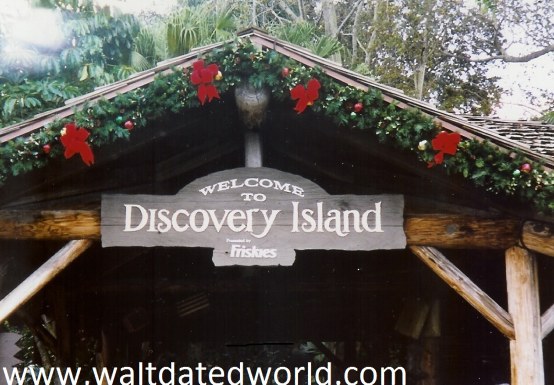
The Beginning
Located in the middle of Bay Lake, Discovery Island was not a man made island. From 1900-1937, it was called Raz Island. The Raz family lived on the island and did some farming on it. The island was purchased for $800.00 in the late 1930's by Delmar "Radio Nick" Nicholson. Radio Nick lived on the island (which he called Idle Bay Isle) for nearly 20 years with his wife and pet sandhill crane. At one point the land was also known as Riles Island. The island then changed hands yet again and was bought by local business people as a hunting retreat before Disney purchased the island in 1965.
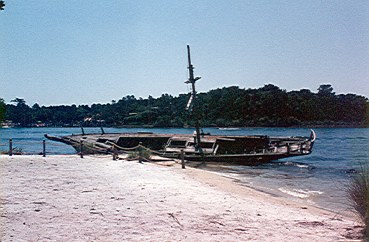
(Photo courtesy of Brotherdave)
Treasure Island
Originally called Blackbeard's Island, the island remained undeveloped until 1974, when it was renamed Treasure Island. The Buena Vista Construction Company added between 15,000 and 50,000 cubic yards of dirt (reports vary as to the amount) to increase the island to 11 and a half acres. The pirate-themed island, complete with shipwreck, opened on April 8, 1974. It could only be accessed by boat. In the early years, the island could be accessed by water launch or by the narrated World Cruise side-wheeler, which included refreshments.
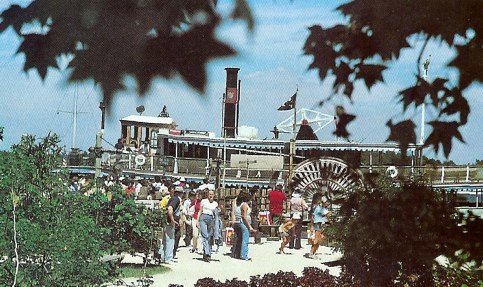
This ad was labeled "rough layout" and appeared in the press book for The Rescuers movie. This promotion was scheduled to run in conjunction with the premier of The Rescuers in June of 1977. The book mentioned how families could win a trip to Walt Disney World, where they had the chance to dig for a $25,000 diamond on Treasure Island. Since this was a rough ad layout and the book would have been created prior to the June movie release, it's possible that this promotion may not have even happened and if it did, the name of the island may have already been changed to Discovery Island by the time the contest occurred.
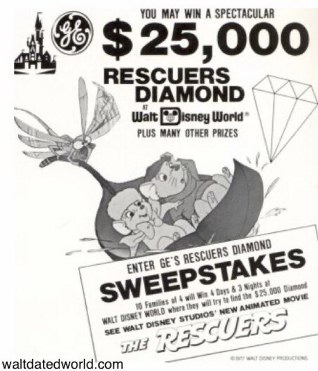
An Expansion and a New Name
The name of the island was changed to Discovery Island sometime in 1977. William Clayton, a former River Country Cast Member from Jacksonville, Florida shared the following information about the name change: "A cast member chose the name Discovery Island in a contest to rename Treasure Island. The fellow who named Discovery Island had to sign waivers of some sort. I can't recall the cast memberís name who won the contest. The prize was, I think, $50."
The walk-through aviary and the Thirsty Perch snack bar/gift kiosk were built at this time. Over 140 species of animals were on the island and the 250 species of tropical plants made for some very lush scenery. Discovery Island was generally open each day from 10 A.M. to 6 P.M. (7 P.M. in the summer). At one time the Island was sponsored by Friskies. It received accreditation by the American Zoo and Aquarium Association in either 1979 or 1981 (reports vary). For Discovery Island ticket prices through the years, check out the Transportation and Ticket Center.
Discovery Island Residents and Places
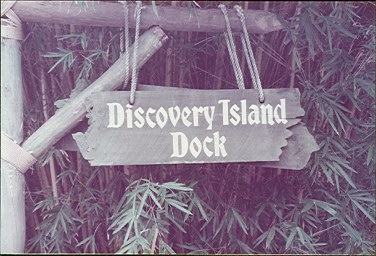
(Photo courtesy of Brotherdave.)
Upon disembarking at the boat dock, the Thirsty Perch would be encountered on the left side of the path. Proceeding in a counter-clockwise direction along the path, the following would typically be encountered:
Parrot's Perch: The Discovery Island Bird Show was located nearby. It included a bird that could stand on his head, green birds Moe, Larry and Curly that could roll over, and a bird named Andrew who could wave goodbye. Shows were generally held four times a day.
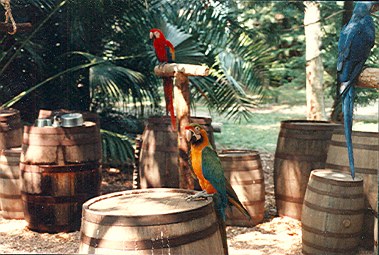
(Photo courtesy by Brotherdave. Taken in 1983.)
Monkey Colony: After passing the North Creek Inlet, the Monkey Colony would be encountered. Starting in 1988, Disney worked in conjunction with a group called Helping Hands: Simian Aides for the Disabled to raise Capuchin monkeys for quadriplegic recipients. Animal Rights groups lobbied Disney to end their support of the program. Disney initially asked the group to relocate the colony but then reversed their decision.
Trumpeter Springs: Home to the largest member of the swan family, the trumpeter. This area consisted of North Falls and Swan's Neck Falls. The Fishing Cat could be seen here.
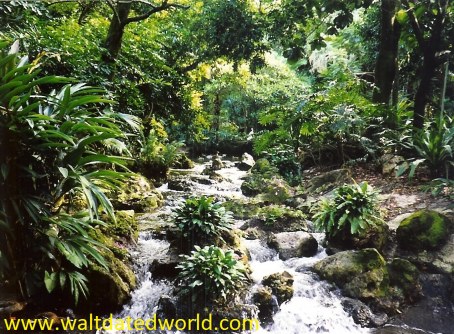
Bamboo Hollow: Five different species of bamboo were planted on the island to protect it against wind and storms. Primate Point was home to lemurs and an African Aviary was nearby.
Vulture's Haunt: There have been some unflattering stories about Disney deliberately killing some of their vulture population, although the birds in question may have been wild and not residents of the island.
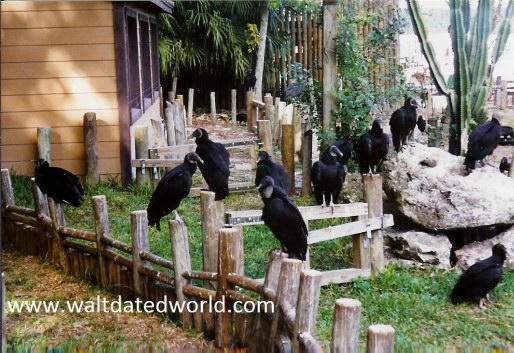
After passing Toucan Corner, one would encounter the Crane's Roost, which was home to the African Crowned, Sandhill and Demoiselle Crane.
Avian Way: At one time is was the largest walk-though aviary in the world. It was home to one of the largest breeding colonies of Scarlet Ibis in the US. Muntjac deer and albino peacocks could also been seen. This area was also known as the South American Aviary. There was also a snack bar here called The Outback.
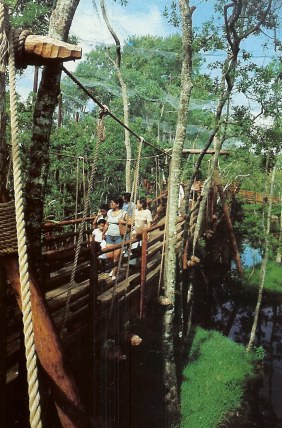
After walking on the Boardwalk and passing the Rookery Pond, guests would find themselves at Pelican Bay. The birds that lived here had been injured and could not survive in the wild.
Flamingo Lagoon: Native flamingos have not lived in Florida since the 1920s. The ones now commonly seen in Florida are Caribbean Flamingos.
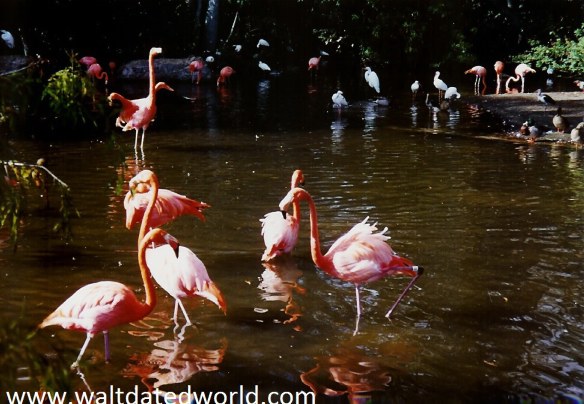
Tortoise Beach: This area of the beach had 11 Galapagos tortoises.
Alligator Pool: This area was also known as Alligator Swamp and was home to Florida's famous reptiles. Reptile Relations featured a demonstration area where shows were held four times a day and a Monkey Canopy was nearby.
Eagle's Watch: The southern bald eagles located here were on loan from the U.S. Department of the Interior.
Other Points of Interest
Airport Display: You knew your vacation was going to start soon when you arrived at the Orlando International Airport and saw the caged birds that promoted the island.
Animal Hospital and Nursery: Usually only viewable from the outside unless a guest was on a tour.
Cavies: Walt Dated World has received many questions from people who remember an animal on Discovery Island that looked like a deer/rabbit/kangaroo. These animals are known alternately as Patagonian Cavies, Patagonian Maras or Patagonian Hares and are a member of the rodent family.
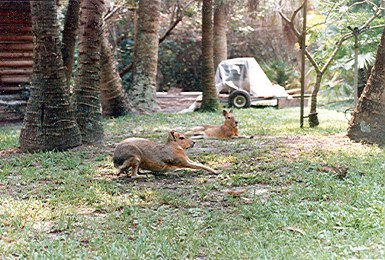
(Photo courtesy of Brotherdave.)
Children's Activities: A tour called Discovery Island Kidventure was offered at least from the early 1990's onward for kids ages 8-14. It included lunch, crafts and a souvenir photo. In 1991, the tour was four hours and cost $25.00. In 1998, the tour was three and a half hours and cost $49.00.
Educational Pavilion: In addition to the children's activities, several nature programs were offered for students. Chip 'n Dale Rescue Rangers Discovery Club was one of these programs.
Logo: This logo could be found on trash cans around the island.
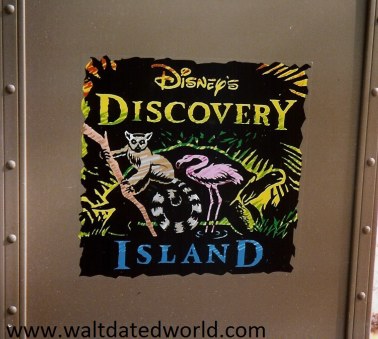
North Creek: Bay Lake would enter the North Creek Inlet to Trumpeter Springs.
South Creek: Bay Lake would enter the South Creek Inlet to the Aviary.
Shipwreck Beach: Get a close up view of the Hispaniola from here.
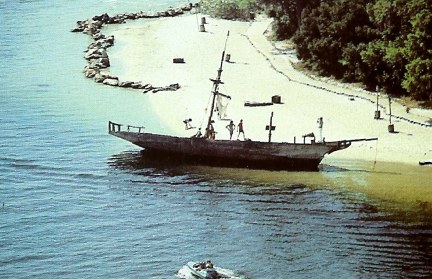
Wildlife Walkway: This was open seasonally due to wild birds that nested there.
Map of Discovery Island (1989)
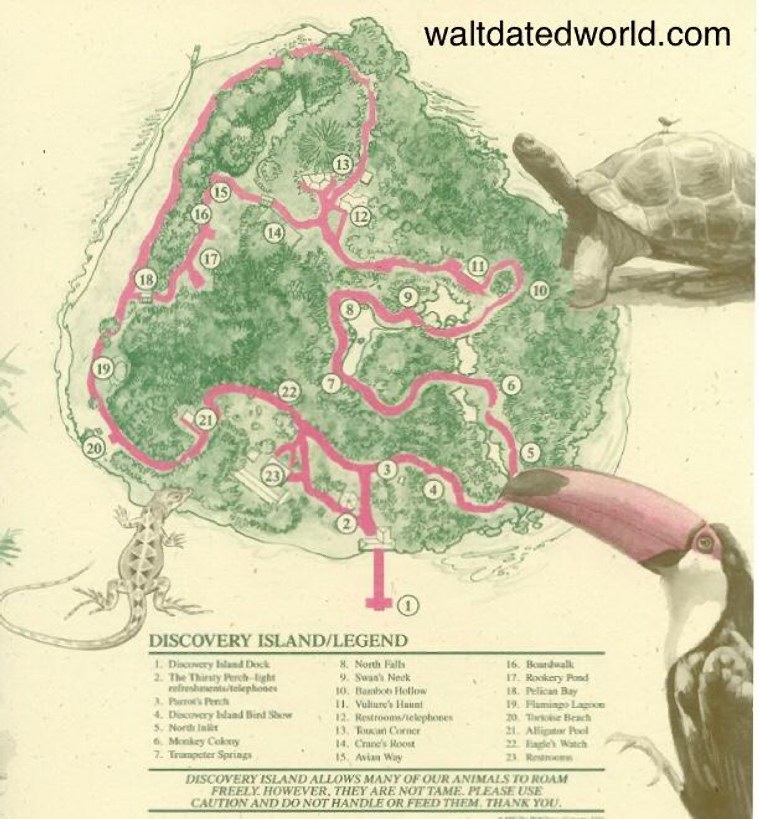
Discovery Island Signs of Conservation Game
In 1998, guests were invited to participate on a scavenger hunt when they arrived on the island. There were given a sheet with 20 clues and the answers could be found on signs throughout the island. The completed sheet could then be turned in at the Thirsty Perch for a Jiminy Cricket Environmentality Earth Day button.
Only about 40 of these birds are left in the wild.
Bali Mynah
This feline mammal is a "superb swimmer" and has webbed feet.
Fishing Cat
Building that contains an "extra strength" x-ray machine.
Animal hospital
Has a bill shaped like a spatula or spoon.
Spoonbill
Blue color lets predators know they are poisonous.
Blue poison arrow frogs
Has eyelashes, which is rare for a bird.
Great Hornbill
Small primate that can leap up to 45 ft. between trees.
Red-handed tamarin
Hatches white but gains pink color from shrimp, algae and mollusks.
American Flamingo
How many different species of butterfly can be found on Discovery Island?
19
Builds gigantic nest with everything from lens caps to stones.
Hammerkap
Only fish-eating duck native to North America.
Hooded Merganser
Animal that needs 6 hours to crawl one mile.
Galapagos Tortoise
Has the most developed eyesight of any bird.
Southern Bald Eagle
Their name means "ghost" in Latin.
Lemur
Having one as a pet is like having a two year old child that NEVER grows up.
Red shoulder macaw
Has a huge CASQUE on top of bill.
Great Hornbill
Is a giant rodent from South America.
Aguti
Builds a nest mound that can be 10 ft. across.
Crocodile
Male is green and female is red.
Red-sided eclectus parrot
How many groups receive support from the Disney Wildlife Conservation Fund. (Hint: Check out the brochure located at the Thirsty Perch.)
10
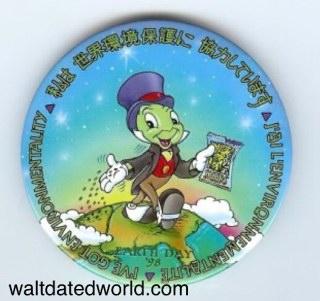
The Arrival of Animal Kingdom and the Exit of Discovery Island
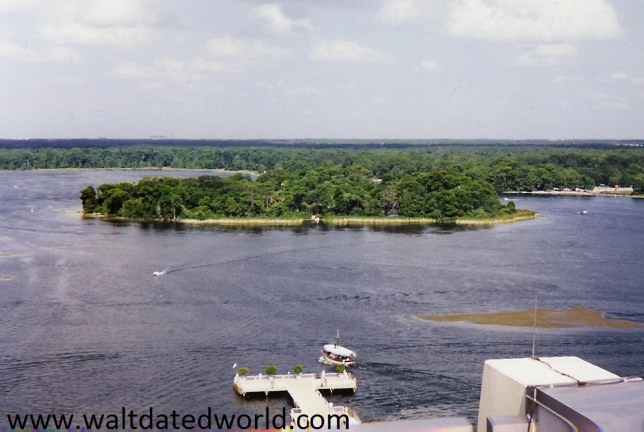
The fact that Discovery Island was accessible only by boat probably caused many time-pressed vacationers to bypass it. The final blow to the island was the opening of Animal Kingdom on April 1, 1998. Discovery Island was used to quarantine many birds while Animal Kingdom was being constructed and some of the island's scarlet ibis flock was relocated to the park once it was built. Discovery Island closed for good on April 8, 1999. The spirit of Discovery Island lives on in portions of Animal Kingdom. In addition to seeing many animal and bird species that used to be on the island, The Safari Village portion of Animal Kingdom was renamed Discovery Island in late 2000 or early 2001.
The Flights of Wonder Bird Show is performed in the Asia section of the park is a reminder of the island's bird show and the Maharajah Jungle Trek features a walk-through aviary. The island is still in the middle of Bay Lake, although it is off-limits to guests. There have been some urban explorers throughout the years who claim to have swam to the island at night or driven to it on a Water Mouse. Walt Dated World reminds you that going to the island is considered trespassing and you will get banned from the property if you are found on it. Several projects were planned for the island after it closed, including a honeymoon resort but nothing has occurred yet.
This is an unofficial fan site that is not affiliated with the Walt Disney Company or Disney theme parks. All copyrights acknowledged. Please respect the work I put into compiling both existing and my own information on this site by not linking to any text or pictures without crediting that they were located on this site.
See ya real soon!